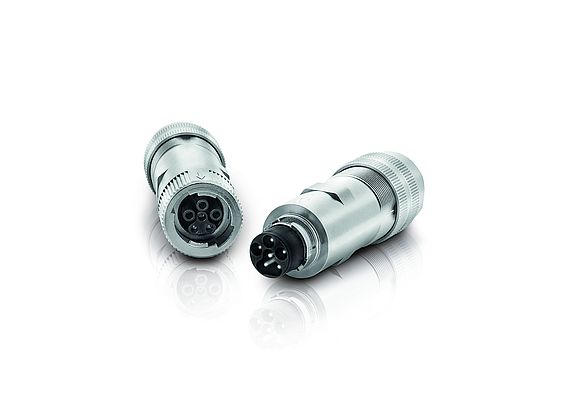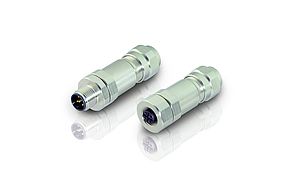binder presents the Power Bayonet Connector PBC15. Its size corresponds to an M15 thread. Thus, in the field of power supply connectors, the PBC15 bridges the gap between the widely used M12 and M23 designs. The compact, yet robust connector is suitable for power supply particularly to three-phase motors or frequency converters. It features 3 power pins, for example to supply the 3 live phases of a 3-phase motor, 2 additional pins for signal transmission, as well as a Protective Earth (PE) contact. The PBC15 design is specified within the DIN EN IEC 61076-2-116 standard. The quick-lock ensures simple, fast, and reliable locking by means of a quarter turn. Termination is provided by screw clamps. The PBC15 is initially available from binder as wireable female or male cable connectors, in each case as an unshielded or shieldable variant.
Fields of application
Thanks to the rated values of 630 V and 16 A for the power interface, the circular connector is suitable for the power supply of small to medium-sized drives. With rated values of 63 V and 10 A, the signal pins can be used, for example, to control brakes or to query operating parameters such as temperatures. The shieldable variants of the Power Bayonet Connector are prepared for use in environments exposed to electromagnetic interference. Typical applications are in the fields of intralogistics, factory and process automation, as well as machine engineering. The compact design of the PBC15 is a unique feature: on the one hand, it offers very little space for an isolation appropriate to the voltage levels. On the other hand, the high currents require wire gauges of up to 2.5 mm² and sufficiently large contacts in order to be able to ideally connect the wires. Nevertheless, the engineers at binder succeeded in designing the PBC15 in such a way that convenient assembly by means of the screw clamp terminals is possible.
Another challenge arose with the coupling of the PE pin, which is designed here as the center contact, to the connector housing. The connection was established by means of a spring plate which was pressed together with the PE contact inside the contact body, thus forming a secure connection to the housing. With the high ampacity of its 3 power contacts and with its 2 signal pins, the connector is extremely versatile in supplying power to automation components and drives. The quick locking as well as the screw clamp termination allow users to easily and quickly wire and install the connector."


















